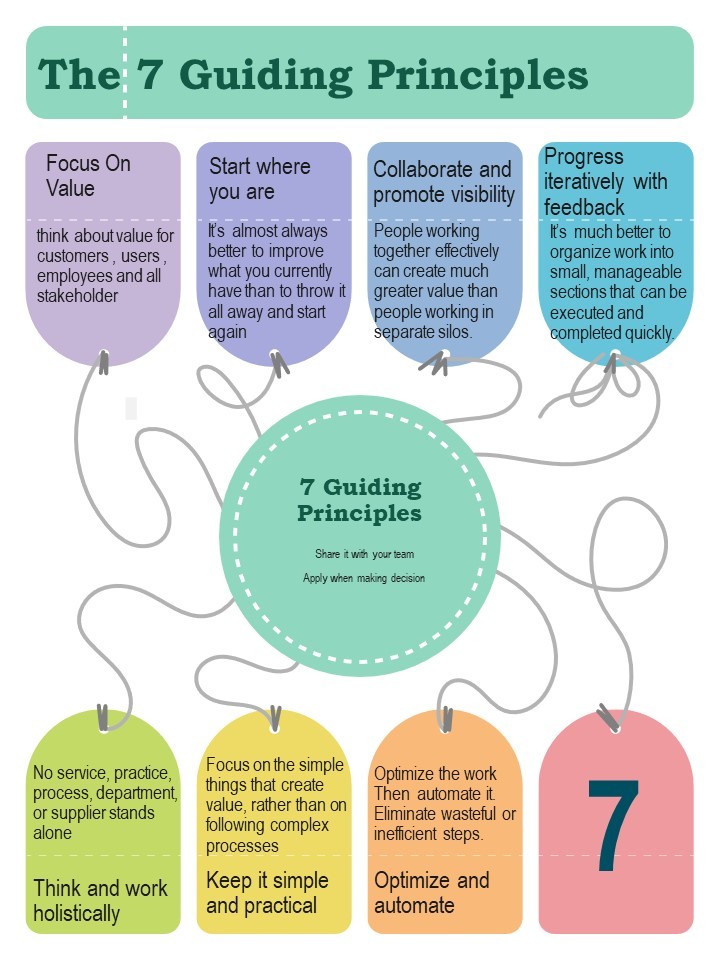ITIL 4— the latest iteration of the Information Technology Infrastructure Library—has emerged as a pivotal framework in the IT service management sphere. It has reshaped the way IT services are delivered and managed. ITIL 4 introduces a flexible, integrated approach that aligns IT services with the diverse and fast-paced needs of modern businesses.
This evolution marks a significant shift from traditional IT management methods, emphasising an approach that is:
- more agile,
- collaborative,
- and customer-centric.
IT professionals who embrace the 7 ITIL 4 guiding principles will find it easier to stay relevant in their chosen field. It helps them:
- lead the charge
- elevate their careers
- and drive their organisations towards excellence in service management.
The 7 ITIL 4 Guiding Principles Explained
This transition in adapting the 7 ITIL 4 Guiding Principles underscores the growing importance of IT roles, transforming them from technical service providers to strategic partners in business success.
1. Focus on Value
At the core of ITIL 4 is the principle of 'Focus on Value.' This principle underlines the importance of understanding that, to customers and users, value extends beyond mere financial metrics. Value in this context encompasses:
- enhancing user satisfaction,
- meeting customer expectations,
- and aligning IT services with business outcomes.
In retail, implementing a new e-commerce platform, the focus on value is evident when IT aligns the platform’s capabilities with customer buying patterns and preferences. This approach boosts sales and customer satisfaction.
In the healthcare industry, IT services that prioritise patient data security and accessibility for medical staff directly contribute to better patient care and operational efficiency. This is an advantage of the multifaceted nature of value in IT service delivery.
2. Start Where You Are
‘Start Where You Are’ is a principle grounded in practicality. It emphasises the importance of assessing and utilising existing capabilities and services before embarking on new initiatives. This approach saves resources and time, promoting incremental improvements.
For example, the IT department in a university might first upgrade its existing hardware to improve network stability and speed instead of overhauling its entire network infrastructure. Starting from the current state and building upon it allows for smoother transitions. It also leverages the value of existing investments.
3. Progress Iteratively with Feedback
These ITIL principals advocate for breaking down major initiatives into smaller, more manageable chunks. It enables teams to respond to feedback and adapt rapidly. For example, a software development company adopting agile methodologies exemplifies this principle. The company can refine and improve its product continuously by delivering in sprints and incorporating user feedback after each iteration. This ensures the company better meets the needs of its users.
4. Collaborate and Promote Visibility
ITIL 4 encourages collaboration and transparency across all levels and departments. Breaking down silos and fostering a culture of openness leads to more effective problem-solving and innovation.
A tech firm that holds cross-departmental meetings to discuss project progress and challenges is an example of this principle in action. This ensures that everyone is on the same page and can contribute to solutions, which leads to better-informed decisions which will result in more cohesive project outcomes.
5. Think and Work Holistically
This principle considers all the components of service management and how they interact to ensure effective and efficient IT services delivery. A holistic approach, when a financial institution implements a new IT system, involves considering:
- how this system interacts with existing processes,
- impacts employee workflows,
- and aligns with the organisation’s goals.
This ensures that new implementations enhance rather than disrupt the service ecosystem.
6. Keep it Simple and Practical
Simplicity and practicality are key in ITIL 4. This principle encourages the elimination of unnecessary complexities in processes and services. A real-life example is a company simplifying its customer support process by reducing the steps required for issue resolution.
For example, a telecommunications company can streamline their customer support by simplifying their phone menu and enhancing the capability of their first-contact representatives. This small change can significantly reduce call transfers between departments, and lead to faster issue resolutions.
This could result in a notable increase in customer satisfaction. The improved efficiency for the support team offered practical benefits, including simplifying processes as advocated by ITIL 4 principles.
7. Optimise and Automate
Optimisation before automation is a critical concept in ITIL 4. It suggests that processes should be streamlined and efficient before they are automated. In the IT sector, this might look like a company refining its data backup processes to ensure they are as efficient as possible before implementing automated backup solutions. This leads to more effective use of resources and reduces the likelihood of errors in automated systems.
The seven guiding principles of ITIL 4 provide a strategic framework for IT professionals to deliver high-quality IT services. By focusing on these principles, IT departments can ensure they are not only meeting the current needs of their organisation, but are also well-prepared for future challenges.

How to Apply the 7 Guiding Principles of ITIL 4
For IT professionals looking to integrate ITIL principles into their daily routines and strategies, the key is in practical application and strategic alignment. Here are actionable steps to effectively incorporate these principles:
- Assessment and Alignment:
- Incremental Implementation:
- Collaborative Culture:
- Simplification and Documentation:
- Holistic Review and Optimisation:
- Continuous Learning and Adaptation:
Begin by assessing current IT processes and services. Identify areas where ITIL 4 principles can enhance efficiency and value delivery. Align these principles with organisational goals and customer needs to ensure a cohesive approach.
Adopt the 'Start Where You Are' and 'Progress Iteratively with Feedback' principles by making incremental changes. Use existing resources as a foundation and improve upon them in stages, incorporating feedback at each step to refine the process.
Foster a culture of collaboration by engaging different departments and stakeholders in IT projects. Use tools and platforms that promote transparency and visibility, ensuring that all parties are informed and can contribute effectively.
Simplify complex processes where possible, keeping them practical and user-friendly. Document these simplified processes, making them accessible for training and future reference.
Regularly review IT services and projects from a holistic perspective. Consider how changes in one area affect the whole system and optimise accordingly. Before automating any process, ensure it’s streamlined and efficient.
Stay informed about the latest ITIL developments and best practices. Be open to adapting and updating strategies as new insights and technologies emerge.
By integrating the 7 ITIL 4 guiding principles, IT professionals can enhance the quality and effectiveness of IT service management. This integration not only improves current operations, but also positions IT departments as vital strategic partners in their organisations.
Continuous Learning and Professional Development
When it comes to IT service management, continuous learning and professional development are paramount. This is especially true with frameworks like ITIL 4. Staying updated with ITIL 4 advancements is crucial for IT professionals to remain relevant and effective.
Resources such as the official ITIL Foundation course with training providers like Career Smarter or LinkedIn Learning, and certification programs offered by other accredited institutions provide valuable knowledge and insights.
Participation in ITIL workshops and webinars, and engagement in ITIL user groups or forums, can further deepen understanding and practical application of ITIL 4 principles.
Charting a Path to IT Excellence with ITIL 4
The 7 ITIL 4 guiding principles offer a comprehensive roadmap for IT service management excellence. By integrating these principles, IT professionals can effectively navigate the complexities of the modern IT landscape, delivering value-focused, efficient, and responsive services.
The principles foster a culture of continuous improvement, collaboration, and strategic alignment with business goals. As the IT domain continues to evolve, adhering to these principles will equip the aspiring IT professional with the necessary tools and mindset to drive innovation and success in their organisations, making them indispensable in the digital era.


